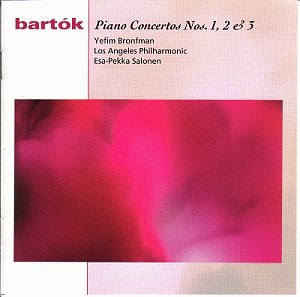Competition for this coupling in the budget and mid-price
sector is strong. Askenazy/Solti, Anda/Fricsay and Kovacevich/Davis
are all favoured contenders, and if modern digital sound is required,
the Naxos disc, with the ever-reliable Jeno Jando, is well worth considering.
So this new re-issue enters a crowded field, but with artists of the
calibre of Bronfman and Salonen, coupled with first-rate sound and super-budget
price tag, this is as good as any in the catalogue.
For some unaccountable reason, Sony have re-ordered
the sequence of the concertos, so that unless you re-programme your
player, you may be brought up short at the start by the strains of the
Second Concerto rather than the First. Once that is sorted, there is
a great deal to enjoy in these performances. What I like chiefly about
Bronfman’s playing is that although the percussive, almost primitively
barbaric nature of some of this music is not under-played, he is equally
determined to show us other aspects of Bartók’s sound world.
This seems almost a revisionist view, chiefly engendered by players
like Schiff and Kocsis, who in turn have looked to Bartók’s own
playing for inspiration. Where Pollini and Abbado, on their amazing
DG disc of Concertos 1 and 2, batter us into submission
in a thrilling display of virtuosity and steely bravura, Bronfman and
Salonen coax another layer of texture and dynamic range out of the music.
Thus, the pounding opening of Concerto No.1 is suitably percussive
and relentless, but it builds in a graded, subtle way that makes it
seem more original, less like second-rate Prokofiev. Both this movement
and the first movement of No.2 benefit enormously from the injection
of point and sparkle, whilst losing nothing of the motoric drive that
is also an essential element. Bronfman’s more lyrical approach predictably
yields major results in the slow movements. The important percussion
parts in the second movement of Concerto No.1 are beautifully
characterised by Salonen and his players, and the atmospheric Night
Music of Concerto No.2 has rarely sounded more evocative
and haunting. Finales of both concertos are thrilling, with fast (-ish)
speeds tempered by precise articulation.
The Third Concerto was written for Bartók’s
wife, Ditta, and is both less aggressive and more classically structured.
It suits Bronfman and Salonen best out of the three, and is given a
marvellously subtle and polished rendition. The delightfully witty opening,
which seems to indicate Bartók’s contentment (or at least peaceful
resignation) at this late stage of his life in the New World, is played
with idiomatic vigour, tempered by a warmth that is rare in Bartók
performances. I have always found the seventeen bar completion of the
finale, by Tibor Serly, to be entirely convincing (it was based on Bartók’s
sketches), and it makes a marvellous conclusion to a very satisfying
reading.
Documentation is minimal but just about adequate. The
recording is cut at a fairly low level, which requires some watching
of the volume control, as the sound is extremely wide-ranging and full-bodied.
It is possible to find a comfortable listening level, and the bass drum
thwacks that litter the pieces are thrilling in their impact. Highly
recommended.
Tony Haywood


